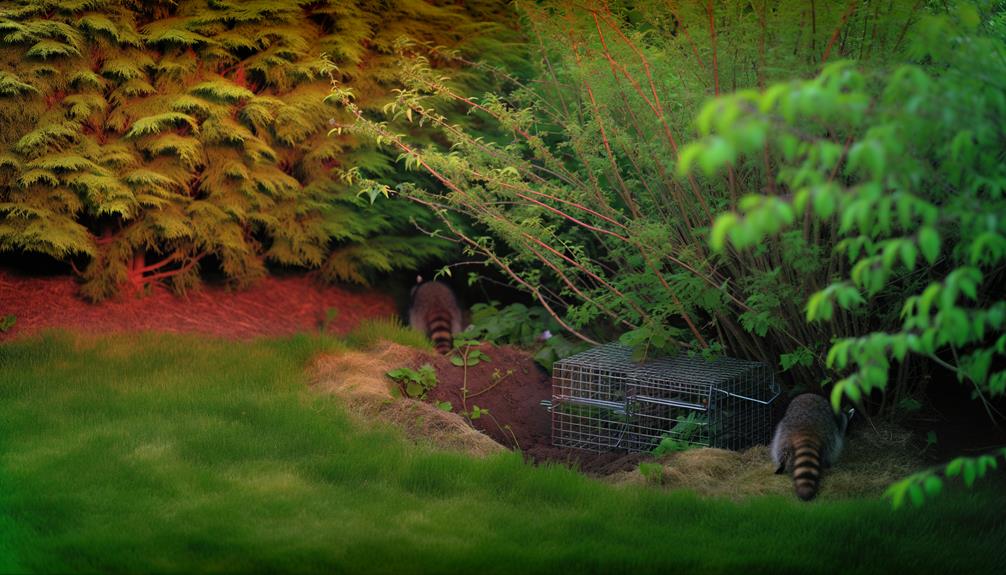How Do You Set a Raccoon Trap in 7 Simple Steps?
Setting a raccoon trap involves several key steps. Select a sturdy live cage trap, ideally between 32 to 42 inches in length with a spring-loaded door and sensitive trigger plate.
Position the trap near areas with signs of raccoon activity, such as overturned trash cans or distinctive footprints. Bait the trap with high-quality bait like marshmallows or canned tuna.
Camouflage the trap using natural materials and guarantee it's stable. Monitor the trap twice daily and handle captured raccoons calmly, releasing them in a safe area away from human habitation.
Key steps and additional details further secure effective and humane trapping.

Key Takeaways
- Place the trap near identified raccoon activity areas such as gardens or trash bins.
- Ensure the trap is stable, level, and well-camouflaged with natural materials like leaves or branches.
- Use high-quality bait like marshmallows or canned tuna to attract raccoons.
- Check the trap twice daily to monitor for any trapped raccoons.
- Approach the trap calmly and choose a distant, suitable release site for humane relocation.
Choosing the Right Trap
Selecting the appropriate trap for raccoons is crucial for guaranteeing both the effectiveness of the capture and the humane treatment of the animal. The most recommended type is a live cage trap, typically constructed from galvanized steel for durability and rust resistance. These traps usually measure around 32 to 42 inches in length, providing adequate space for the raccoon without causing distress.
The trap should feature a spring-loaded door mechanism that guarantees quick and secure closure once the raccoon enters. Additionally, selecting a trap with a sensitive trigger plate increases the likelihood of capture. It is also advisable to choose traps with smooth internal edges to prevent injury to the animal. Adhering to these specifications guarantees ethical and efficient trapping.
Gathering Necessary Supplies
Ensuring a successful raccoon trapping endeavor necessitates the careful assembly of all required supplies. Begin with a sturdy, appropriately sized live trap, constructed from durable materials to withstand raccoon attempts to escape.
High-quality bait, such as marshmallows, canned tuna, or cat food, is essential for attracting raccoons into the trap. Additionally, protective gloves are essential to safely handle both the trap and the animal.
A tarp or old blanket can be useful for covering the trap once the raccoon is captured, minimizing stress for the animal. For humane relocation, a transport container or vehicle equipped to securely hold the trapped raccoon is necessary.
Identifying Raccoon Activity
With all necessary supplies gathered, the next critical step is to accurately identify raccoon activity in order to strategically place the trap. Key indicators of raccoon presence include overturned trash cans, scattered food remnants, and distinctive footprints. Look for tracks that are approximately two to three inches long, with five distinct toes.
Additionally, raccoons are nocturnal; evidence of nighttime disturbances can be a strong indicator. Examine areas around gardens, bird feeders, and accessible attics or basements. Raccoon droppings, typically dark and tubular, can also signal their presence.
Setting Up the Trap
Positioning the trap correctly is crucial to guaranteeing a successful capture of the raccoon.
First, place the trap near known raccoon activity areas, such as garbage bins or garden plots. This increases the likelihood of attracting the animal.
Second, make sure the trap is stable and level on the ground to prevent it from tipping over when the raccoon enters.
Third, camouflage the trap with natural materials like leaves or branches to make it less conspicuous.
Location: Place the trap in high-traffic raccoon areas.
Stability: Make sure the trap is level and stable.
Camouflage: Use natural materials to conceal the trap.
Following these steps will greatly enhance the effectiveness of your trapping efforts.
Monitoring and Releasing
Regularly monitoring the trap is vital to secure the humane treatment of the captured raccoon and to prevent prolonged stress to the animal. Inspections should occur at least twice daily, once in the morning and once in the evening. Upon capture, approach the trap calmly to avoid alarming the raccoon. When releasing the animal, select an appropriate location, ideally a wooded area far from human habitation.
| Step | Action |
|---|---|
| 1. Frequent Checks | Inspect trap twice daily. |
| 2. Calm Approach | Approach trap calmly to avoid distress. |
| 3. Suitable Location | Choose a release site away from humans. |
| 4. Safe Release | Open trap and allow the raccoon to exit. |
This method secures the raccoon is treated ethically and minimizes the risk of return to residential areas.
Conclusion
In summation, the meticulous process of setting a raccoon trap necessitates selecting an appropriate trap, assembling essential supplies, pinpointing raccoon activity, and carefully setting up the trap.
Vigilant monitoring and humane releasing are crucial to secure success. Mastering these steps will transform individuals into unparalleled experts in raccoon trapping, akin to trapping legends.
Such proficiency not only guarantees effective capture but also upholds ethical standards, promoting a balanced coexistence between humans and wildlife.






